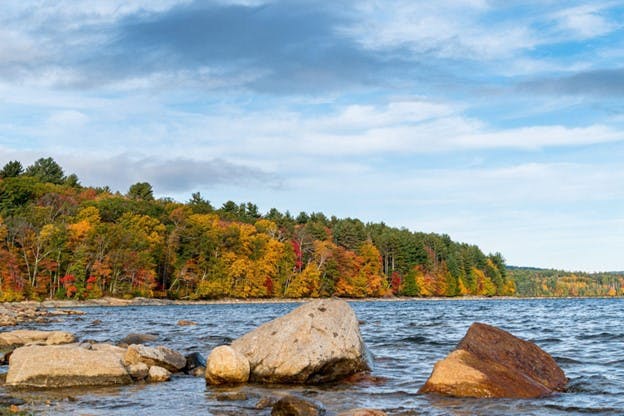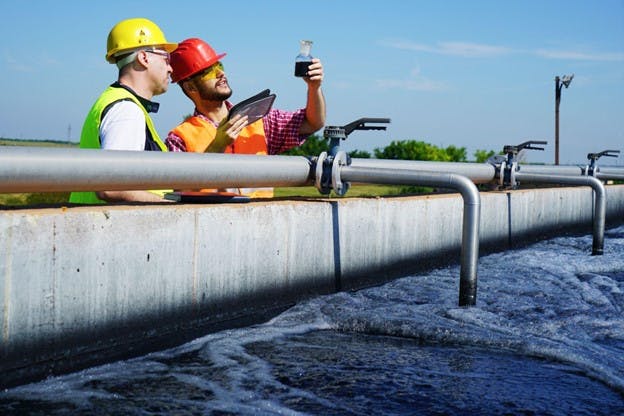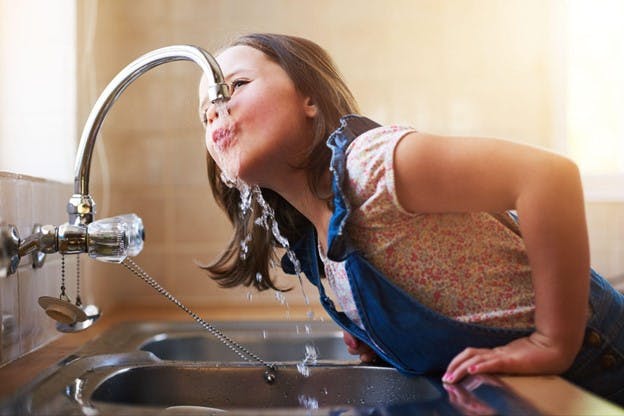🌟 New Arrival! Upgrade Your Water with Our Advanced Pitcher Filter. Shop Now
August 2023
Boston Water Quality: Is It Your Cup of Tea?
Boston, Massachusetts is an iconic city if there ever was one. It’s as central to the founding of the United States as it is to shaping its culture. The first college (Harvard), the first public beach, the first subway, the first Thanksgiving, the oldest baseball stadium, the first chocolate factory, and even the first home of Dunkin’ Donuts.
All this in one of the country's smallest major cities in terms of land mass. With only 48.4 square miles of land to hold its 650k residents, Boston just sizes out San Francisco, making Beantown the second smallest major city in the U.S.
But what makes Boston really special isn't its land, but its water. Boston is 46% water. There’s the Massachusetts Bay, the Charles River, and one of the country’s most iconic bodies of water, the Boston Harbor (of Tea Party fame).
Of course, the water in Boston isn’t just historic, it's also vital to the health and wellbeing of over 650,000 Bostonians who rely on it. In this article, we want to dive deep into Boston water quality to find out where it comes from, what challenges the city faces, and whether or not you should be filtering your water.
Where Does Boston Water Come From?
With all the water in Boston, you might be surprised to learn that none of your drinking water actually comes from the immediate Boston area. Instead, water is piped in from the Wachusett reservoirs and the Quabbin Reservoirs in central Massachusetts. The Massachusetts Water Resource Authority (MWRA) and the Department of Conservation and Recreation (DCR) care for these watersheds which provide a combined 200 million gallons of water per day to 53 different communities.
Water treatment and transport is handled by the MWRA. To make sure they are delivering clean water to each customer, the source water is tested and treated using several different methods. Because the water is unfiltered, it needs to be tested often. The MWRA publishes the test results from the hundreds of thousands of tests they do each year in the annual water quality report.
In between all those tests, the water is treated using:
- Ozone: A pure oxygen treatment that kills living pathogens like bacteria while helping to remove sediment and improve its taste.
- Ultraviolet light (UV): A chemical-free water disinfection method that uses cleansing light to inactivate living pathogens.
- Fluoride: An additive to water that has been shown to improve dental health in communities that use it.
- Chloramines: A mixture of chlorine and ammonia that takes much longer to break down than just chlorine by itself. Chloramines are a chemical disinfectant that are very effective at killing pathogens in water.
The water is also treated to make it less corrosive to pipes. Some of the water mains and service lines still have lead. Since lead is a neurotoxin that is extremely dangerous to children and pregnant women, it’s very important it does not leach into your water. The U.S Center for Disease Control (CDC) says there are no safe levels of lead in the blood of children.
Is Boston Water Quality Good?
Boston water quality is better than in many other cities. In 2021, Boston water won the “Best of the Best” award in a national water taste test. The taste test was the 16th annual event held by the American Water Works Association.
While the water directly around Boston has had some problems over the years with pollution, The Massachusetts Department of Environmental Protection and the Department of Conservation and Recreation have gone through great lengths to ensure the source of the city’s drinking water stays pristine.
The water systems are protected from the car traffic and stormwater runoff that has polluted so many of the state’s other waterways. They’ve done such a good job at protecting them they’ve been able to avoid building costly water filtration plants. This is a rare accomplishment that is only shared by a handful of other major cities. The biggest of which is Boston’s friendly rival and neighbor, New York City.
While Boston has high quality water compared to many, there are some problems which we’ll look at in these next few sections.
Is It Safe to Drink the Tap Water in Boston?
Tap water in Boston is considered safe to drink by EPA standards.
Since the passage in 1974 of the Safe Water Drinking Act, the Environmental Protection Agency (EPA) has been responsible for creating drinking water standards in the U.S. They currently enforce limits on 92 different substances in public water supplies. These limits are based on known health effects and the cost effectiveness of removing them.
While this is a huge step in the right direction for drinking water safety, there are thousands of compounds out there that we don’t know enough about to know whether there should be limits.
Some contaminants like microplastics are known to be in water supplies across the globe but since there are no reliable testing and filtering methods, there have been no limits placed on them either.
Contaminants like PFAS have been polluting drinking water supplies in the U.S. since the 1950s. Even though companies have been voluntarily phasing them out since 2000 due to mounting evidence of their possible danger, it's taken until 2023 for the EPA to suggest adding it to the list of contaminants with enforceable limits.
Our understanding of contaminants and their dangers evolve steadily over time, but it can take regulators a long time to catch up. According to D.C.-based water watchdog, the Environmental Working Group (EWG), if the EPA does pass new regulations, it will be the first change made to the water regulations in 20 years.
The EWG points out that scientists now believe many of the regulated limits on contaminants to be far too high for safety. Let’s look at some of the chemicals currently found in Boston’s water which are deemed safe by regulators but are questionable based on modern science.
What Chemicals Are in Boston Water?
One of the biggest problems Boston water quality faces is disinfection byproducts (DBPs). When chlorine and chloramines interact with organic matter, they can create carcinogenic DBPs. While these are at levels considered safe by regulators, the EWG disagrees.
Haloacetic Acids (HAA5)
HAA5 is made up of five haloacetic acids: monochloroacetic acid, dichloroacetic acid, trichloroacetic acid, monobromoacetic acid, and dibromoacetic acid. These chemicals are known as disinfection byproducts, as they result from disinfectants like chlorine interacting with organic matter in water. Long-term exposure to HAA5 can lead to cancer.
Levels of HAA5 in Boston water have exceeded what the EWG recommends for safety by 106 times:
- EPA maximum allowance: 60 parts per billion (ppb)
- EWG recommended maximum: 0.1 ppb
- Boston maximum contaminant level: 10.6 ppb
Haloacetic Acids (HAA9)
HAA9 includes all of the contaminants from HAA5 but adds bromochloroacetic acid, bromodichloroacetic acid, chlorodibromoacetic acid, and tribromoacetic acid. These are also disinfection byproducts and are also cancer-causing.
Levels of HAA9 in Boston water have exceeded what the EWG recommends for safety by 281 times:
- EPA maximum allowance: No legal limit
- EWG recommended maximum: 0.06 ppb
- Boston maximum contaminant level: 16.8 ppb
Total Trihalomethanes (TTHMs)
TTHMs — like the haloacetic acids above — are formed when chlorine interacts with organic compounds in drinking water. They’re also known to be carcinogenic. This category is made up of four chemicals: chloroform, bromodichloromethane, dibromochloromethane, and bromoform.
Levels of TTHMs in Boston water have exceeded what the EWG recommends for safety by 90 times:
- EPA maximum allowance: 80 ppb
- EWG recommended maximum: 0.15 ppb
- Boston maximum contaminant level: 13.5 ppb
Radium
Radium is a radioactive heavy metal found both in nature and as a byproduct of oil and gas production. Radium is a known carcinogen. Legal limits for radium are measured in picocuries per liter (pCi/L), which is a measure of radioactivity.
Radium levels in Boston water have exceeded what the EWG recommends for safety by 18 times:
- EPA maximum allowance: 5 pCi/L
- EWG recommended maximum: 0.05 pCi/L
- Boston maximum detected level: 0.88 pCi/L
Why Does Boston Water Taste Fishy or Swampy
No matter how much you protect your water from manmade pollution, nature is still a factor. While Boston’s water might win taste awards, Bostonians know it’s not always so good.
In the spring and the fall, many people report their water tasting fishy, earthy, or swampy. The good news is that this isn’t dangerous. The bad news is your water spends months tasting like a swamp.
The taste is because of algae that grows in the reservoirs. Different types of algae cause your water’s flavor to change. Some give your water a flowery taste while others are far less pleasant. And since Boston doesn’t filter its water, these flavors can be strong.
A popular suggestion if you don’t have a water filter is a twist of lemon in your glass.
Is Boston Tap Water Hard or Soft?
While much of the water in the United States is considered hard water, Boston is fortunate enough to have soft water.
Water hardness is a measure of dissolved minerals in water like calcium and magnesium. As water travels through and over the ground, it tends to break down and carry with it small pieces of mineral. While these minerals aren’t dangerous to our health, they can wreak havoc on your surfaces, skin, clothing, and water-using appliances.
Having soft water means you have very low concentrations of these minerals in your water and can rest easy.
Does Boston Add Fluoride to Their Water?
Yes, Boston does add fluoride to their water. Fluoride is added to many modern water supplies as a public health initiative to enhance Boston water quality. Fluoride is known to help prevent cavities and strengthen tooth enamel.
While many people are happy to have fluoride in their water, others would rather have more control over their fluoride use or intake. If you want to filter fluoride out of your water, it's important to know that most regular carbon water filters do not remove fluoride. Instead, you need reverse osmosis filtration.
Get the Best Quality Water in Your Boston Home
Boston is a city with an incredibly rich history that endures today. Its bodies of water are celebrated and so is its drinking water. Still, Boston water quality isn't perfect. Its use of chemical disinfectants creates levels of disinfection byproducts that worry many scientists and organizations. And while the flavor is award-winning sometimes, the taste and smell of your water is at the whim of what’s growing in the reservoir.
If you want the best-tasting water no matter what time of year it is, HomeWater can help. Our American-made UPSTREAM 4-Stage Whole Home Water Filter uses specialized catalytic carbon filter media that removes chloramines and the DBPs they leave behind. It will also remove particulates, heavy metals, chlorine, VOCs, PFOS/PFAS, and more.
If you live in an apartment and need something more manageable, try our HomeWater EZChange 2-Stage Under Counter Under Sink Water Filter. It’s easy to install and provides glass after glass of great-tasting, crystal clear water. It greatly reduces chlorine, lead, sediment, VOCs (volatile organic compounds), microplastics, particulates, heavy metals, mercury, chloroform, and cysts.
Not sure which is right for you? Take our quick filter quiz and find out. In just a few clicks, you’ll know the perfect filter for your needs.


